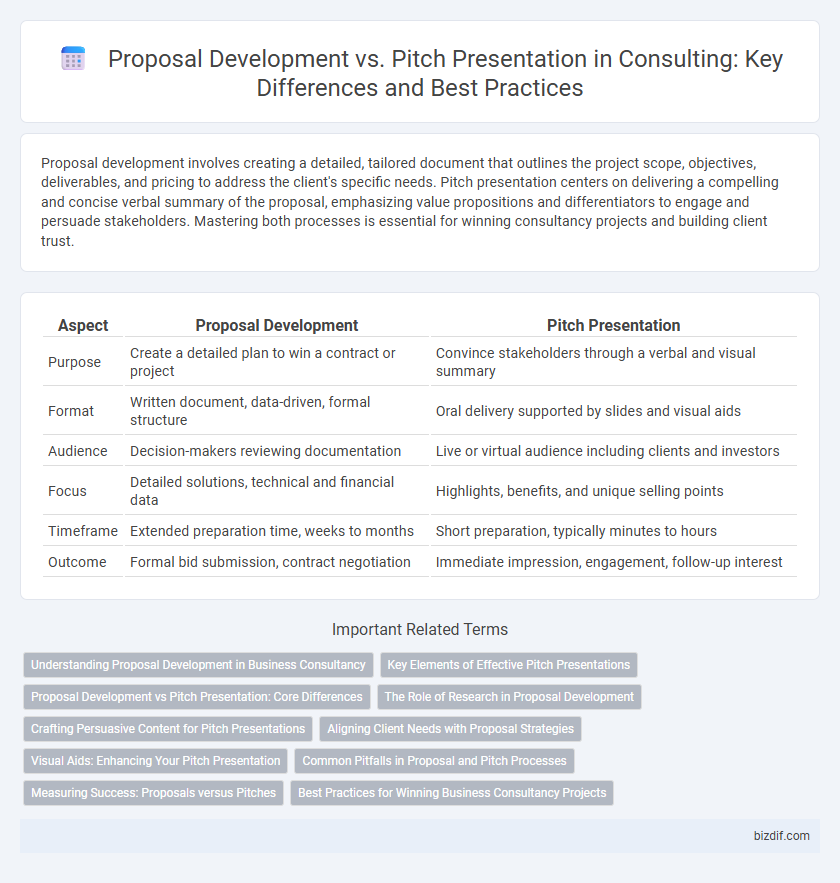Proposal development involves creating a detailed, tailored document that outlines the project scope, objectives, deliverables, and pricing to address the client's specific needs. Pitch presentation centers on delivering a compelling and concise verbal summary of the proposal, emphasizing value propositions and differentiators to engage and persuade stakeholders. Mastering both processes is essential for winning consultancy projects and building client trust.
Table of Comparison
| Aspect | Proposal Development | Pitch Presentation |
|---|---|---|
| Purpose | Create a detailed plan to win a contract or project | Convince stakeholders through a verbal and visual summary |
| Format | Written document, data-driven, formal structure | Oral delivery supported by slides and visual aids |
| Audience | Decision-makers reviewing documentation | Live or virtual audience including clients and investors |
| Focus | Detailed solutions, technical and financial data | Highlights, benefits, and unique selling points |
| Timeframe | Extended preparation time, weeks to months | Short preparation, typically minutes to hours |
| Outcome | Formal bid submission, contract negotiation | Immediate impression, engagement, follow-up interest |
Understanding Proposal Development in Business Consultancy
Proposal development in business consultancy involves crafting a detailed plan that outlines how the consultancy will address a client's specific challenges and objectives, including scope, methodology, timeline, and budget. It requires thorough research, clear articulation of value propositions, and alignment with client needs to increase the likelihood of project approval. Effective proposal development sets the foundation for trust, demonstrating expertise and strategic insight before advancing to pitch presentations.
Key Elements of Effective Pitch Presentations
Key elements of effective pitch presentations include a clear value proposition, concise storytelling, and compelling visuals that engage the audience. Presenters must emphasize unique selling points and anticipated outcomes to differentiate their proposal from competitors. Strong delivery skills and addressing client pain points enhance credibility and increase the likelihood of project approval.
Proposal Development vs Pitch Presentation: Core Differences
Proposal development involves creating a detailed, structured document outlining project objectives, scope, methodology, timeline, and budget tailored to client requirements. Pitch presentation focuses on delivering a compelling, concise oral or multimedia summary designed to persuade stakeholders and highlight key benefits, value propositions, and competitive advantages. The core differences lie in the depth of information, format, and primary purpose: proposals provide comprehensive project plans, while pitches aim at engaging and convincing decision-makers quickly.
The Role of Research in Proposal Development
Research plays a critical role in proposal development by providing data-driven insights that shape tailored solutions addressing client needs. Comprehensive market analysis and competitor evaluation ensure proposals are strategically aligned and feasible. This foundation improves the credibility and precision of the proposal compared to pitch presentations, which often emphasize persuasive delivery over detailed research.
Crafting Persuasive Content for Pitch Presentations
Crafting persuasive content for pitch presentations requires a strategic blend of clear problem identification, tailored solutions, and compelling value propositions that resonate with the client's needs. Effective pitch presentations emphasize storytelling, data-driven insights, and visual aids that enhance understanding and engagement, differentiating them from the more detailed and comprehensive proposal development process. Prioritizing audience-centric messaging and concise, impactful language increases the likelihood of securing client approval and advancing consultancy projects.
Aligning Client Needs with Proposal Strategies
Proposal development requires in-depth research and strategic planning to tailor solutions that address specific client pain points, ensuring alignment with their business objectives. Pitch presentations emphasize clear communication and persuasive storytelling to highlight the proposal's value proposition and demonstrate how it meets or exceeds client expectations. Aligning client needs with proposal strategies increases the likelihood of successful project acquisition and long-term partnership building.
Visual Aids: Enhancing Your Pitch Presentation
Visual aids in pitch presentations significantly enhance message clarity by providing engaging graphics, charts, and videos that support key points and data. Unlike proposal development, where detailed written documents are central, pitch presentations rely on visual elements to capture attention and facilitate understanding within a limited timeframe. Effective use of visuals boosts client engagement, reinforces the consultant's credibility, and increases the likelihood of winning projects.
Common Pitfalls in Proposal and Pitch Processes
Common pitfalls in proposal development include vague objectives, lack of client-specific customization, and underestimating resource requirements, which lead to weak value propositions. In pitch presentations, issues such as overloading slides with information, failing to engage the audience, and poor time management often undermine message clarity. Addressing these challenges requires thorough research, clear storytelling, and strategic rehearsal to enhance impact and win rates.
Measuring Success: Proposals versus Pitches
Measuring success in proposal development centers on win rates, client feedback, and alignment with project requirements, while pitch presentation success is gauged through audience engagement, persuasive storytelling, and immediate client reactions. Proposals provide a detailed roadmap for project scope and terms, facilitating long-term evaluation metrics, whereas pitches rely on real-time impact and emotional connection to secure preliminary interest. Effective consultancy balances quantitative analysis from proposal success metrics with qualitative insights derived from pitch performance to optimize business growth.
Best Practices for Winning Business Consultancy Projects
Proposal development requires clear articulation of client needs, tailored solutions, and detailed project plans to demonstrate value and feasibility. Pitch presentations should emphasize concise storytelling, engaging visuals, and confident delivery to create a compelling case for selection. Integrating thorough market research, competitive analysis, and client feedback enhances credibility and increases the likelihood of winning consultancy projects.
Proposal Development vs Pitch Presentation Infographic

 bizdif.com
bizdif.com